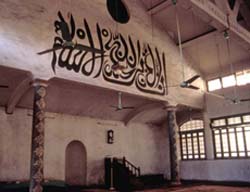
The Great Mosque of Guangzhou, known also as Huaisheng Mosque (Memorial of the Holy Prophet) or the Guangta Mosque (Light Tower Mosque), is thought to be the earliest surviving mosque in China and has the earliest freestanding minaret in China.
Manuscripts from 1206 claim that the mosque was built by an uncle of the Prophet, Abi Waqqas, on the first Muslim mission to China in the 630s. However, it is more certain that a mosque was first built here during the Tang Dynasty, or in the early years of the Song Dynasty. The mosque was entirely rebuilt in 1350 during the Yuan dynasty under the rule of Zhizheng (1341-1368), and rebuilt again in 1695 under Emperor Kangzi of the Qing dynasty, after being destroyed in a fire. The Huaisheng Light Tower, the mosque's unique namesake minaret, was built at an earlier period. Like its contemporaries at Quanzhou, Hangzhou and Yangzhou, the Great Mosque of Guangzhou is notable for its integration of the local Han building tradition with imported Arab styles.
The mosque complex covers an area of about 3,000 square meters and stretches along the north-south axis, in the Chinese fashion. Entered from a red-brick gate with a green awning on Guangta Road to the south, the mosque complex consists of a U-shaped corridor enclosing a courtyard with a large Bangke tower to the north, followed by the prayer hall. The streetscape is marked by the mosque's most famous feature, the old minaret or light tower, which flanks the main gate behind the street wall.
From the main gate, a narrow courtyard enclosed with high brick walls passes by the old light tower to its left and leads to an inner gateway. This monumental gateway is styled after a bangke tower, consisting of a wooden structure encased in brick. Its stacked, double-eaved meru roof is carried on pronounced dougong brackets. This gateway tower bears an inscriptive plaque in Chinese that reads: "Religion that holds in great esteem the teachings brought from the Western Region." The U-shaped corridor begins at either side of this gateway and wraps around the inner courtyard facing the prayer hall.
The prayer hall was rebuilt in concrete in 1935. A portico wraps around the north, east and southern sides of the prayer hall, arcaded with columns joined by half dougong joints. When the structure was rebuilt, its main entrance was moved from the east to the south fa?ade of the hall so as to open directly into the courtyard to its south. The mihrab is placed in a shallow semi-circular niche that projects beyond the western wall. Its hipped roof, which is supported on two internal columns in addition to the walls, is covered with green tiles. A line of windows separates the two tiers of this stacked roof.
Guang Minaret (Light Tower)
Guang Minaret (Light Tower) had a different role from that of pagodas and was used to call Muslims to prayer.
The minaret had been called Bangke, which was changed to Guang because the Chinese pronunciation of bangke is very close to that of guang. Also, lights used to be put on top of the minaret to guide ships and the body of the minaret is upright and smooth.
Guang Minaret is in Huaisheng Mosque, one of the earliest mosques in China commemorating Mohammed, founder of Islam. It is said to have been built by an Arab priest who came to China a thousand years ago in the early Tang Dynasty.
The minaret is a cylindrical brick structure 36.3 meters high. A central pillar has a winding staircase leading to the top. On top is a platform with balustrades for calling Muslims to prayer. Rising from the platform is a column topped by a pavilion. The minaret's structure is different from that of other ancient towers.
The Light Tower has no precedent in China with its thick cylindrical masonry shaft and internal stairway. One of the earliest examples of Islamic architecture in China, it mimics Arabic styles while also attempting to integrate them with the local architectural styles. Its tapering brick shaft rises to a height of thirty-six meters atop a ten meter stone base. The minaret balcony, which is used for the call to prayer, is thought once to have had a beacon to guide boats on the Zhujiang River at night. It is said that when ships sailing along this segment of the river considered the tower as the sign that they had arrived at the beginning of the "maritime silk road". Above the balcony, the minaret is capped with a gourd-shaped dome on a thin turret. The base of the dome is decorated with two tiers of dougong brackets, adding a Chinese character to the minaret.
Two intertwined staircases, a structural feat not seen in China prior to the Song Dynasty, give access to the balcony, and are expressed on the exterior with windows that spiral up the tower. An inscription added to the mosque at the time of its reconstruction in 1350 states the following: "beneath white clouds and where the mountain turns, there stands a brilliant stone pagoda in the style of the Western Regions. Handed down by Emperor Gaozu of the Tang dynasty to the present, its style is unknown in the Central Region," suggesting a completion date between 650 and 700 for the minaret. Until recently, the Light Tower minaret was the tallest structure in Guangzhou and served as a main landmark in the city.
The complex also includes quarters for the imam, a tablet pavilion for the storage of scripture, and an ablution area, all composed in the open pagoda style with traditionally sculpted and tiled roofs complimenting the roofs of the prayer hall and of the secondary gateway.
|